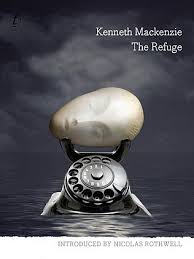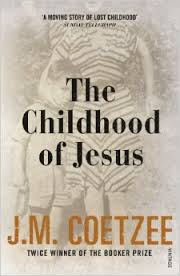1. Would you continue with a novel, a murder mystery if, in the first five pages, the narrator told you not only who the murderer was, but confessed Hedunnit.
That’s how Kenneth McKenzie’s 1954 novel The Refuge begins. It then held me tightly in its clasp for another 420 pages.
I only read it because I had read an excerpt from Nicholas Rothwell’s introduction to the Text Classic reprint. I admire Rothwell and this piece in the Weekend Australian Review (the only reason to buy the Murdoch rag) intrigued me: ‘Can a work of genius, a masterwork – a classic – be imperfect, flawed in its essence?’ is how it began.
And flawed it is, but the writing is so wonderful, the insights into immediate pre-war and post-war Sydney and its attitudes to the European refugees flowing in, its description of Kings Cross (where I grew up) and the Blue Mountains (where my grandfather lived) so intriguing I stayed with it.
It is a very masculine book and those seeking to retrofit political correctness may throw it aside. But lovers of forgotten good Australian literature might want to go and seek it out. The tragedy of McKenzie, in hindsight, also hangs over the book.
2. I have just finished a very difficult book. The Childhood of Jesus by J.M.Coetzee. I was glad to read that the learned reviewers of this book also had difficulty with it. In the New York Times Benjamin Markovits writes in some despair ‘[Coetzee] knows what he’s doing but he’s not going to tell you what that is, and I spent much of The Childhood of Jesus trying to figure it out. I can’t say I have figured it out.’
Is it about Jesus? Is the six year old protagonist, David, Jesus? Is the adult protagonist, Simón, his guardian, Joseph? Is the arbitrarily chosen mother, Inés, at 30 a virgin (broad hint) Mary? Well, not arbitrarily, Simón knows she is the boy’s mother, by insight, when he sees her playing tennis with her brothers at La Residencia, a country club just outside the bleak and passionless city of Novilla.
A brief outline. Simón and David turn up at Novilla, by boat, without pasts, washed clean. The only clue to David’s past was in a letter which was lost on the sea voyage. There are hints that the boat sank. The people of Novilla speak Spanish, but it is not in Spain, nor, as far as the reader can gather, in South America. It is just a place. The food is frugal, at first just bread, then a sort of a bean paste soup. There is a shop, Naranja (orange in Spanish) that sells fruit and vegetables, but it has odd hours and when Simón gets a job as a stevedore, it’s usually closed when he finishes work.
The other stevedores are inclined to philosophical discussion, and many attend the Institute where one can enrol in classes: philosophy, life drawing et cetera.
Simón finds somewhere to live for himself and the boy in the East Village, which reads like a cluster of soulless Soviet style apartments. David goes to school, and finds a friend, Fidel. His mother Elena and Simón enter into a bloodless relationship, Elena allows him to slake his bestial needs on her, but takes little part herself.
The boy David he gives up to Inés who takes on the responsibility with zeal. She tries to keep Simón away from him, which Simón goes along with half-heartedly. He loves the boy and is worried that Inés is over-protective, and is trying to ‘feminise’ him.
The boy is strange. He claims to be able to read and write and understand numbers. But his reading is fantastical, fantasies he makes up, his writing gibberish and his numbers plucked out of the air. He worries about holes opening up, holes in numbers. Is he autistic? Is he a genius? Is he Jesus? I am inclined to think it is a Jesus-like parable, or a messianic parable as is there is no way of turning Jesus into an adjective (Jesuitical is a whole other kettle of fish). Why do I think so? Two major clues.
David is thrown out of his school and sent to a correctional school, Punto Arenas which he does not like and escapes from. He is thrown out of school because he is disruptive, because he challenges the authority of the teacher, Señor León and because he refuses to learn to read or write, maintaining, through his gibberish, that he can.
This episode underlines the authoritarian nature of Novilla. There is no choice. He must go. But Simón and Inés persuade the school to give him a second chance and the three of the go to an interview with Señor León.
There, David astounds all by reading and writing with ease and grace. He reds from his favourite book, Don Quixote curiously in Coetzee’s world, not by Cervantes but someone called Benengeli who wears a long robe and has a turban on his head,see below) and then, when Señor León asks him to write down as a dictation exercise the phrase Conviene que yo digo la verdad (I agree that I tell the truth) David writesYo soy la verdad (I am the truth).
“I am the way and the truth and the life” said Jesus before being crucified.
And the second clue – there are a few others but these are the biggies – is on the very last page. Craig Sherborne’s review in The Monthly (by far the best in my opinion between Joyce Carol Oates in the New York Times and Markovits in The Guardian suggests that:
Novilla may be a representation of purgatory, where good souls soiled by minor sin go to suffer a little and thereby be cleansed in preparation for eternal life. Simón’s intuition tells him that arrivals are “all supposed to be washed clean by the passage here” in readiness for a new life. He wonders how long he has to wait in order to “emerge as a new, perfected man”.
This makes perfect sense to me. Purgatory as a stern, austere self-improving Soviet style existence. They are forced to escape, David, Simón and Inés and the dog Bolívar (?), and head north towards Estrellita (little star) they have an adventure and David is temporarily blinded by a present given to them by the malevolent Señor Daga, who I haven’t mentioned because he is a whole other complication, may be the devil, may be the representation of freedom, and may have seduced Inés. He tells David that she, Inés, has the most beautiful breasts in the world.
So now, having recovered from his blindness, they are all in the car, and pick up a hitchhiker called Juan – John (the Evangelist, who knew Jesus?) – are headed for the Relocation Centre in Estrellita where they will say ‘Looking for somewhere to stay, to start our new life.’
Resurrection? Ask Señor Coetzee. Yo soy la verdad.
And finally, Benengeli. Cide Hamet Benengeli is the fictional Moorish author created by Cervantes and listed by him as as the chronicler of the adventures of Don Quixote. It is curious that Joyce Carol Oates, in her review, is perplexed by this and appears not to know who Benegeli is or was.
The book is perplexing, also fascinating and an annoyingly intrusive work from a remarkable writer whose ability to tell powerful and penetrating stories are told with a frugal almost miserly use of language.


